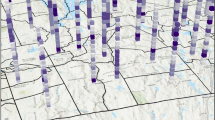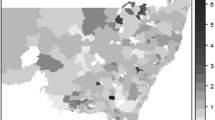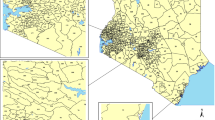Abstract
Morbidities generally show patterns of concentration that vary by space and time. Disease mapping models are useful in estimating the spatiotemporal patterns of disease risks and are therefore pivotal for effective disease surveillance, resource allocation, and the development of prevention strategies. This study considers six spatiotemporal Bayesian hierarchical models based on two spatial conditional autoregressive priors. It could serve as a guideline on the development and application of Bayesian hierarchical models to assess the emerging risk trends, risk clustering, and spatial inequality trends, with estimation of covariables’ effects on the interested disease risk. The method is applied to the Florida Birth Record data between 2006 and 2015 to study two cardiovascular risk factors: preeclampsia and gestational diabetes. High-risk clusters were detected in North Central Florida for preeclampsia and in Central Florida for gestational diabetes. While the adjusted disease trend was stable, spatial inequality peaked in 2011–2012 for both diseases. Exposure to PM2.5 at first or/and second trimester increased the risk of preeclampsia and gestational diabetes, but the magnitude is less severe compared to previous studies. In conclusion, this study underscores the significance of selecting appropriate disease mapping models in estimating the intricate spatiotemporal patterns of disease risk and suggests the importance of localized interventions to reduce health disparities. The result also identified an opportunity to study potential risk factors of preeclampsia, as the spike of risk in North Central Florida cannot be explained by current covariables.







Similar content being viewed by others
Data availability
Data use approval is needed from the Florida Department of Health.
Abbreviations
- AR1:
-
first order autoregressive
- BHM:
-
Bayesian hierarchical model
- BMI:
-
body mass index
- CAR:
-
conditional autoregressive
- DIC:
-
deviance information criterion
- GDM:
-
gestational diabetes mellitus
- IQR:
-
interquartile range
- LISA:
-
local indicators of spatial association
- PE:
-
preeclampsia
- SD:
-
standard deviation
- SIR:
-
standardized incidence ratio
- WAIC:
-
widely applicable information criterion
References
Anderson C, Lee D, Dean N (2017) Spatial clustering of average risks and risk trends in Bayesian disease mapping. Biom J 59(1):41–56. https://doi.org/10.1002/bimj.201600018
Bernardinelli L, Clayton D, Pascutto C, Montomoli C, Ghislandi M, Songini M (1995) Bayesian analysis of space-time variation in disease risk. Stat Med 14(21-22):2433–2443. https://doi.org/10.1002/sim.4780142112
Besag J, York J, Mollié A (1991) Bayesian image restoration, with two applications in spatial statistics. Ann Inst Stat Math 43:1–20. https://doi.org/10.1007/BF00116466
Billet S, Garçon G, Dagher Z, Verdin A, Ledoux F, Cazier F, Courcot D, Aboukais A, Shirali P (2007) Ambient particulate matter (PM2.5): physicochemical characterization and metabolic activation of the organic fraction in human lung epithelial cells (A549). Environ Res 105(2):212–223. https://doi.org/10.1016/j.envres.2007.03.001
Brooks SP, Gelman A (1998) General methods for monitoring convergence of iterative simulations. J Comput Graph Stat 7(4):434–455. https://doi.org/10.1080/10618600.1998.10474787
Buchanan TA, Xiang AH, Page KA (2012) Gestational diabetes mellitus: risks and management during and after pregnancy. Nat Rev Endocrinol 8(11):639–649. https://doi.org/10.1038/nrendo.2012.96
Casagrande SS, Linder B, Cowie CC (2018) Prevalence of gestational diabetes and subsequent type 2 diabetes among U.S. women. Diabetes Res Clin Pract 141:200–208. https://doi.org/10.1016/j.diabres.2018.05.010
Cramb SM, Moraga P, Mengersen KL et al (2017) Spatial variation in cancer incidence and survival over time across Queensland, Australia. Spat Spatio Temp Epidemiol 23:59–67. https://doi.org/10.1016/j.sste.2017.09.002
Daniel S, Kloog I, Factor-Litvak P, Levy A, Lunenfeld E, Kioumourtzoglou M (2021) Risk for preeclampsia following exposure to PM2.5 during pregnancy. Environ Int 156:106636. https://doi.org/10.1016/j.envint.2021.106636
DeSisto CL, Kim SY, Sharma AJ (2014) Prevalence estimates of gestational diabetes mellitus in the United States, Pregnancy Risk Assessment Monitoring System (PRAMS), 2007-2010. Prev Chronic Dis 11:E104. https://doi.org/10.5888/pcd11.130415
Di Q, Amini H, Shi L, Kloog I, Silvern R, Kelly J, Sabath MB, Choirat C, Koutrakis P, Lyapustin A, Wang Y, Mickley LJ, Schwartz J (2019) An ensemble-based model of PM2.5 concentration across the contiguous United States with high spatiotemporal resolution. Environ Int 130:104909. https://doi.org/10.1016/j.envint.2019.104909
Di Q, Wei Y, Shtein A, Hultquist C, Xing X, Amini H, Shi L, Kloog I, Silvern R, Kelly JT, Sabath MB, Choirat C, Koutrakis P, Lyapustin A, Wang Y, Mickley LJ (2021) Daily and annual PM2.5 concentrations for the contiguous United States, 1-km grids, v1 (2000-2016). In: NASA Socioeconomic Data and Applications Center (SEDAC). https://doi.org/10.7927/0rvr-4538
Duley L (2009) The global impact of pre-eclampsia and eclampsia. Semin Perinatol. https://doi.org/10.1053/j.semperi.2009.02.010
Duncan EW, White NM, Mengersen K (2017) Spatial smoothing in Bayesian models: a comparison of weights matrix specifications and their impact on inference. Int J Health Geogr 33(3):130–137. https://doi.org/10.1186/s12942-017-0120-x
Fox R, Kitt J, Leeson P, Aye CYL, Lewandowski AJ (2019) Preeclampsia: risk factors, diagnosis, management, and the cardiovascular impact on the offspring. J Clin Med 8(10):1625. https://doi.org/10.3390/jcm8101625
Gelman A, Rubin DB (1992) Inference from iterative simulation using multiple sequences. Stat Sci 7(4):457–472. https://doi.org/10.1214/ss/1177011136
Getis A (2010) Spatial Autocorrelation. In: Fischer MM, Getis A (eds) Handbook of applied spatial analysis: software tools, methods and applications. Springer, Berlin Heidelberg, Berlin, Heidelberg, pp 255–278
Griffith DA (2009) Spatial Autocorrelation. In: Kitchin R, Thrift N (eds) International Encyclopedia of Human Geography. Elsevier, Oxford, pp 308–316
Grimes DA, Schulz KF (2008) Making sense of odds and odds ratios. Obstet Gynecol 111(2 Pt 1):423–426. https://doi.org/10.1097/01.AOG.0000297304.32187.5d
Guimarães MF, Brandão AH, Rezende CA, Cabral AC, Brum AP, Leite HV, Capuruço CA (2014) Assessment of endothelial function in pregnant women with preeclampsia and gestational diabetes mellitus by flow-mediated dilation of brachial artery. Arch Gynecol Obstet 290(3):441–447. https://doi.org/10.1007/s00404-014-3220-x
Haberzettl P, O'Toole TE, Bhatnagar A, Conklin DJ (2016) Exposure to fine particulate air pollution causes vascular insulin resistance by inducing pulmonary oxidative stress. Environ Health Perspect 124(12):1830–1839. https://doi.org/10.1289/EHP212
Hassan AA (2021) Spatial data analysis : applications to population health. Statistics [math.ST]. Université de Lille. English. NNT : 2021LILUB021. https://theses.hal.science/tel-03685200/document
Hu C, Gao X, Fang Y, Jiang W, Huang K, Hua X, Yang X, Chen H, Jiang Z, Zhang X (2020) Human epidemiological evidence about the association between air pollution exposure and gestational diabetes mellitus: systematic review and meta-analysis. Environ Res 180:108843. https://doi.org/10.1016/j.envres.2019.108843
Kannan S, Misra DP, Dvonch JT, Krishnakumar A (2006) Exposures to airborne particulate matter and adverse perinatal outcomes: a biologically plausible mechanistic framework for exploring potential effect modification by nutrition. Environ Health Perspect 114(11):1636–1642. https://doi.org/10.1289/ehp.9081
Karacay Ö, Sepici-Dincel A, Karcaaltincaba D, Sahin D, Yalvaç S, Akyol M, Kandemir Ö, Altan N (2010) A quantitative evaluation of total antioxidant status and oxidative stress markers in preeclampsia and gestational diabetic patients in 24–36 weeks of gestation. Diabetes Res Clin Pract 89(3):231–238. https://doi.org/10.1016/j.diabres.2010.04.015
Knorr-Held L (2000) Bayesian modelling of inseparable space-time variation in disease risk. Stat Med 19(17-18):2555–2567. https://doi.org/10.1002/1097-0258(20000915/30)19:17/18<2555::AID-SIM587>3.0.CO;2-%23
Kottas A, Duan JA, Gelfand AE (2008) Modeling disease incidence data with spatial and spatio temporal dirichlet process mixtures. Biom J 50(1):29–42. https://doi.org/10.1002/bimj.200610375
Lawson AB (2018) Bayesian disease mapping: hierarchical modeling in spatial epidemiology. CRC press
Lee D, Rushworth A, Napier G (2018) Spatio-temporal areal unit modeling in r with conditional autoregressive priors using the CARBayesST package. J Stat Softw 84:1–39. https://doi.org/10.18637/jss.v084.i09
Lee P, Roberts JM, Catov JM, Talbott EO, Ritz B (2013) First trimester exposure to ambient air pollution, pregnancy complications and adverse birth outcomes in Allegheny County, PA. Matern Child Health J 17(3):545–555. https://doi.org/10.1007/s10995-012-1028-5
Leroux BG, Lei X, Breslow N (2000) Estimation of disease rates in small areas: a new mixed model for spatial dependence. In: Halloran ME, Berry D (eds) Statistical Models in Epidemiology, the Environment, and Clinical Trials. Springer, New York, NY. https://doi.org/10.1007/978-1-4612-1284-3_4
MacNab YC (2022) Bayesian disease mapping: past, present, and future. Spat Stat 50:100593. https://doi.org/10.1016/j.spasta.2022.100593
MacNab YC, Dean CB (2001) Autoregressive spatial smoothing and temporal spline smoothing for mapping rates. Biometrics 57(3):949–956. https://doi.org/10.1111/j.0006-341x.2001.00949.x
Miron-Celis M, Talarico R, Villeneuve PJ, Crighton E, Stieb DM, Stanescu C, Lavigne É (2023) Critical windows of exposure to air pollution and gestational diabetes: assessing effect modification by maternal pre-existing conditions and environmental factors. Environ Health 22(1):26. https://doi.org/10.1186/s12940-023-00974-z
Napier G, Lee D, Robertson C, Lawson A, Pollock KG (2016) A model to estimate the impact of changes in MMR vaccine uptake on inequalities in measles susceptibility in Scotland. Stat Methods Med Res 25(4):1185–1200. https://doi.org/10.1177/0962280216660420
Orozco-Acosta E, Adin A, Ugarte MD (2023) Big problems in spatio-temporal disease mapping: methods and software. Comput Methods Prog Biomed 231:107403. https://doi.org/10.1016/j.cmpb.2023.107403
Rioux C, Grandbastien B, Astagneau P (2006) The standardized incidence ratio as a reliable tool for surgical site infection surveillance. Infect Control Hosp Epidemiol 27(8):817–824. https://doi.org/10.1086/506420
Rohr Thomsen C, Brink Henriksen T, Uldbjerg N, Milidou I (2020) Seasonal variation in the hypertensive disorders of pregnancy in Denmark. Acta Obstet Gynecol Scand 99(5):623–630. https://doi.org/10.1111/aogs.13786
Rue H, Martino S, Chopin N (2009) Approximate Bayesian inference for latent Gaussian models by using integrated nested Laplace approximations. J R Stat Soc, B: Stat Methodol 71(2):319–392. https://doi.org/10.1111/j.1467-9868.2008.00700.x
Rushworth A, Lee D, Mitchell R (2014) A spatio-temporal model for estimating the long-term effects of air pollution on respiratory hospital admissions in Greater London. Spat Spatiotemporal Epidemiol 10:29–38. https://doi.org/10.1016/j.sste.2014.05.001
Rushworth A, Lee D, Sarran C (2017) An adaptive spatiotemporal smoothing model for estimating trends and step changes in disease risk. J R Stat Soc, C: Appl Stat 66(1):141–157. https://doi.org/10.1111/rssc.12155
Saenen ND, Vrijens K, Janssen BG, Roels HA, Neven KY, Vanden Berghe W, Gyselaers W, Vanpoucke C, Lefebvre W, De Boever P (2017) Lower placental leptin promoter methylation in association with fine particulate matter air pollution during pregnancy and placental nitrosative stress at birth in the ENVIR ON AGE cohort. Environ Health Perspect 125(2):262–268. https://doi.org/10.1289/EHP38
Sławek-Szmyt S, Kawka-Paciorkowska K, Ciepłucha A, Lesiak M, Ropacka-Lesiak M (2022) Preeclampsia and fetal growth restriction as risk factors of future maternal cardiovascular disease-a review. J Clin Med 11(20):6048. https://doi.org/10.3390/jcm11206048
Tang X, Zhou J, Luo F, Han Y, Heianza Y, Cardoso MA, Qi L (2020) Air pollution and gestational diabetes mellitus: evidence from cohort studies. BMJ Open Diabetes Res Care 8(1):e000937. https://doi.org/10.1136/bmjdrc-2019-000937
Ugarte MD, Adin A, Goicoa T (2017) One-dimensional, two-dimensional, and three dimensional B-splines to specify space–time interactions in Bayesian disease mapping: model fitting and model identifiability. Spat Stat 22:451–468. https://doi.org/10.1016/j.spasta.2017.04.002
Verburg PE, Dekker GA, Tucker G, Scheil W, Erwich JJHM, Roberts CT (2018) Seasonality of hypertensive disorders of pregnancy-a South Australian population study. Pregnancy Hypertens 12:118–123. https://doi.org/10.1016/j.preghy.2018.04.006
Waller LA, Carlin BP (2010) Disease mapping. Chapman Hall CRC Handb Mod Stat Methods 2010:217–243. https://doi.org/10.1201/9781420072884-c14
Weinberg CR, Shi M, Basso O, DeRoo LA, Harmon Q, Wilcox AJ, Skjærven R (2017) Season of conception, smoking, and preeclampsia in Norway. Environ Health Perspect 125(6):067022. https://doi.org/10.1289/EHP963
Yi L, Wei C, Fan W (2017) Fine-particulate matter (PM2.5), a risk factor for rat gestational diabetes with altered blood glucose and pancreatic GLUT2 expression. Gynecol Endocrinol 33(8):611–616. https://doi.org/10.1080/09513590.2017.1301923
Yin P, Mu L, Madden M et al (2014) Hierarchical Bayesian modelling of spatio-temporal patterns of lung cancer incidence risk in Georgia, USA: 2000–2007. J Geogr Syst 16:387–407. https://doi.org/10.1007/s10109-014-0200-4
Yu H, Yin Y, Zhang J, Zhou R (2020) The impact of particulate matter 2.5 on the risk of preeclampsia: an updated systematic review and meta-analysis. Environ Sci Pollut Res Int 27(30):37527–37539. https://doi.org/10.1007/s11356-020-10112-8
Zhang Y, Wang J, Chen L, Yang H, Zhang B, Wang Q, Hu L, Zhang N, Vedal S, Xue F, Bai Z (2019) Ambient PM2.5 and clinically recognized early pregnancy loss: a case-control study with spatiotemporal exposure predictions. Environ Int 126:422–429. https://doi.org/10.1016/j.envint.2019.02.062
Zhou X, Lin H (2008) Spatial Weights Matrix. In: Shekhar S, Xiong H (eds) Encyclopedia of GIS. Springer, US, Boston, MA, p 1113
Acknowledgements
The authors would like to thank the FL-DOH for providing the data and acknowledge that the findings and conclusions are those of the authors and do not necessarily represent the official position of the Florida Department of Health.
Funding
This work is supported by The National Heart Lung and Blood Institute (Grant number: K01 HL146944).
Author information
Authors and Affiliations
Contributions
Conceptualization, B.I.; methodology, N.S., B.I., S.D.; formal analysis, N.S.; resources, B.I.; writing—original draft preparation, N.S.; writing—review and editing, B.I., R.L, Z.B., I.D.. All authors have read and agreed to the published version of the manuscript.
Corresponding author
Ethics declarations
Ethical approval
This study is approved with FIU IRB-20-0033.
Consent to participate
Informed consent was obtained from all subjects involved in the study by Florida Department of Health.
Consent for publication
Informed consent was obtained from all subjects involved in the study by Florida Department of Health.
Competing interests
The authors declare no competing interests. Findings and conclusions are those of the authors and do not necessarily represent the official position of the Florida Department of Health.
Additional information
Responsible Editor: Lotfi Aleya
Publisher’s Note
Springer Nature remains neutral with regard to jurisdictional claims in published maps and institutional affiliations.
Appendix
Appendix
Rights and permissions
Springer Nature or its licensor (e.g. a society or other partner) holds exclusive rights to this article under a publishing agreement with the author(s) or other rightsholder(s); author self-archiving of the accepted manuscript version of this article is solely governed by the terms of such publishing agreement and applicable law.
About this article
Cite this article
Sun, N., Bursac, Z., Dryden, I. et al. Bayesian spatiotemporal modelling for disease mapping: an application to preeclampsia and gestational diabetes in Florida, United States. Environ Sci Pollut Res 30, 109283–109298 (2023). https://doi.org/10.1007/s11356-023-29953-0
Received:
Accepted:
Published:
Issue Date:
DOI: https://doi.org/10.1007/s11356-023-29953-0










